Canon D340, D320 User Manual
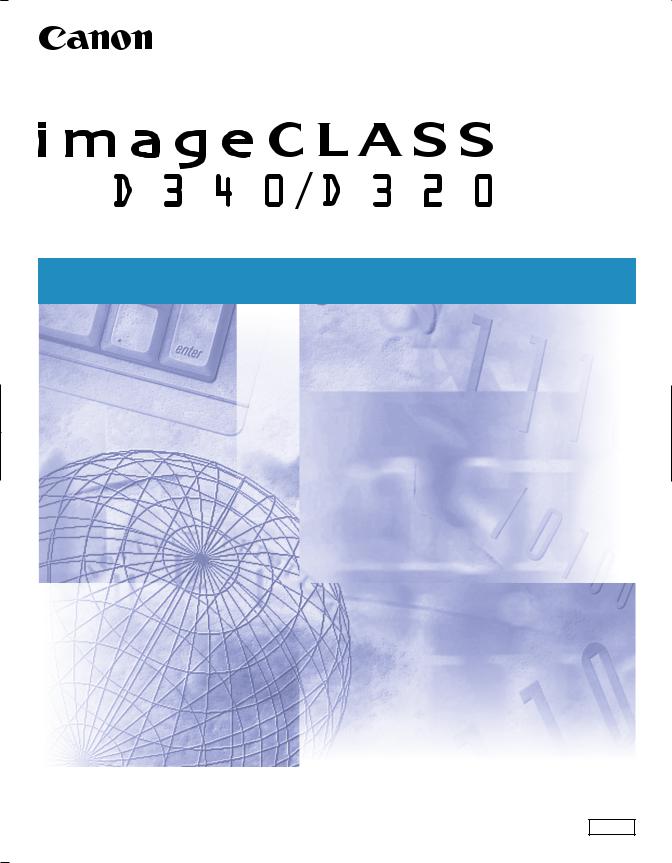
Basic Guide
Please read this guide before operating this equipment. |
ENG |
After you finish reading this guide, store it in a safe place for future reference. |
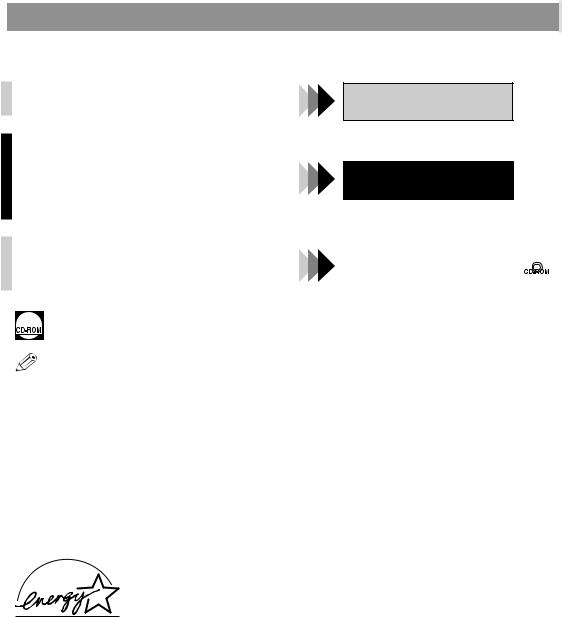

 Using Your Documentation
Using Your Documentation
Your machine includes the following documentation. This documentation has been designed so that you can easily use your machine to suit your particular needs.
Setting up the machine......................................
Installing Printer Driver .....................................
Document and paper handling .............................
Making copies ................................................
Printing.........................................................
Maintenance ..................................................
Troubleshooting feed and copy issues ....................
Set-Up Sheet
Basic Guide
Installing Printer Driver ..................................... |
|
|
|
............................................Printer Properties |
Printer Guide |
|
|
|
|
||
Troubleshooting Printer Driver issues |
|
|
|
|
|
|
|
|
|
|
 • Documentation is included on the CD-ROM in PDF form.
• Documentation is included on the CD-ROM in PDF form.
• The machine shown in this guide is the imageCLASS D340 model.
NOTE
Copyright
Copyright ©2003 by Canon, Inc. All rights reserved. No part of this publication may be reproduced, transmitted, transcribed, stored in a retrieval system, or translated into any language or computer language in any form or by any means, electronic, mechanical, magnetic, optical, chemical, manual, or otherwise, without the prior written permission of Canon, Inc.
Trademarks
Canon is a registered trademark and UHQ™ is a trademark of Canon, Inc.
As an ENERGY STAR® Partner, Canon U.S.A., Inc. has determined that this product meets the ENERGY STAR® guidelines for energy efficiency.
i
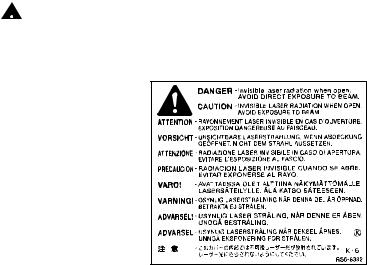
Laser Safety
This machine complies with 21 CFR Chapter 1 Subchapter J as a Class 1 laser product under the U.S. Department of Health and Human Services (DHHS) Radiation Performance Standard according to the Radiation Control for Health and Safety Act of 1968. This means that the machine does not produce hazardous laser radiation.
Since radiation emitted inside the fax is completely confined within protective housings, and external covers, the laser beam cannot escape from the machine during any phase of user operation.
CDRH Regulations
The Center for Devices and Radiological Health (CDRH) of the U.S. Food and Drug Administration implemented regulations for laser products on August 2, 1976. These regulations apply to laser products manufactured from August 1, 1976. Compliance is mandatory for products marketed in the United States.
 • Use of controls, adjustments or performance of procedures other than those specified in this user’s CAUTION guide may result in hazardous radiation exposure.
• Use of controls, adjustments or performance of procedures other than those specified in this user’s CAUTION guide may result in hazardous radiation exposure.
This label is attached to the laser scanner unit inside the fax and is not in a user access area.
ii

Users in the USA
FCC NOTICE imageCLASS D320 : H12255 imageCLASS D340 : H12256
This device complies with Part 15 of the FCC Rules. Operation is subject to the following two conditions.
(1)This device may not cause harmful interference, and
(2)this device must accept an interference received, including interference that may cause undesired operation.
•This equipment has been tested and found to comply with the limits for a class B digital
device, pursuant to Part 15 of the FCC Rules. These limits are designed to provide reasonable
NOTE
protection against harmful interference in a residential installation. This equipment generates, uses, and can radiate radio frequency energy and, if not installed and used in accordance with the instructions, may cause harmful interference to radio communications. However, there is no guarantee that interference will not occur in a particular installation. If this equipment does cause harmful interference to radio or television reception, which can be determined by turning the equipment off and on, the user is encouraged to try to correct the interference by one or more of the following measures:
–Reorient or relocate the receiving antenna.
–Increase the separation between the equipment and receiver.
–Connect the equipment into an outlet on a circuit different from that to which the receiver is connected.
–Consult the dealer or an experienced radio/TV technician for help.
Use of shielded cable is required to comply with class B limits in Subpart B of Part 15 of the FCC Rules.
Do not make any changes or modifications to the equipment unless otherwise specified in the manual. If such changes or modifications should be made, you could be required to stop operation of the equipment.
Canon U.S.A. Inc.
One Canon Plaza, Lake Success, NY 11042, U.S.A.
Tel No. (516) 328-5000
Users in Canada
•This Class B digital apparatus meets all requirements of the Canadian Interference-Causing Equipment Regulations.
IMPORTANT
Cet appareil numérique de la classe B respecte toutes les exigences du Règlement sur le matériel brouilleur du Canada.
CANON CANADA INC. 1-800-263-1121
24 HOURS A DAY, SEVEN DAYS A WEEK
iii


 Contents
Contents
Chapter 1: Introduction |
|
Customer Support ............................................. |
1-1 |
Important Safety Instructions ........................... |
1-1 |
Main Components of the Machine ................... |
1-4 |
Operation Panel ................................................ |
1-6 |
Standby Display ................................................ |
1-7 |
Energy Saver Mode........................................... |
1-8 |
Setting the Energy Saver Mode Manually ..... |
1-8 |
Restoring from the Energy Saver Mode ........ |
1-8 |
Chapter 2: Paper Handling |
|
Print Media Requirements................................. |
2-1 |
Printing Areas ................................................ |
2-2 |
Loading Paper .................................................. |
2-3 |
Loading Paper in the Cassette ...................... |
2-3 |
Loading Envelopes in the Cassette ............... |
2-4 |
Loading Paper in the Multi-purpose Tray ....... |
2-5 |
Loading an Envelope |
|
in the Multi-purpose Tray................................ |
2-6 |
Selecting the Paper Output Area ...................... |
2-8 |
Paper Type and Paper Output Area............... |
2-8 |
Face Down Paper Output Area...................... |
2-9 |
Face Up Paper Output Area .......................... |
2-9 |
Chapter 3: Document Handling |
|
Documents You Can Copy ............................... |
3-1 |
Scanned Area of a Document ....................... |
3-2 |
Setting Up Documents ...................................... |
3-3 |
Placing a Document on the Platen Glass...... |
3-3 |
Loading Documents in the ADF (Only for the |
|
imageCLASS D340 model) ........................... |
3-4 |
The Paper Path of the Automatic Document |
|
Feeder (Only for the imageCLASS D340 |
|
model) ........................................................... |
3-5 |
Chapter 4: Making Copies |
|
Documents You Can Copy ............................... |
4-1 |
Copying Documents ......................................... |
4-1 |
Canceling the Copy Job................................. |
4-2 |
Basic Copying Functions................................... |
4-3 |
Making Multiple Copies.................................. |
4-3 |
Specifying the Paper Size and the Type (Common |
|
for Cassette and Multi-purpose Tray) ................ |
4-3 |
Setting Enlarging/Reducing ........................... |
4-5 |
Setting the Image Quality .............................. |
4-6 |
Adjusting the Copy Exposure ........................ |
4-6 |
Special Features ............................................... |
4-7 |
Collate Copy .................................................. |
4-7 |
2 on 1 Copy ................................................... |
4-9 |
Reserve Copy .............................................. |
4-11 |
Chapter 5: Basic Printing |
|
from Your Computer |
|
Before Printing................................................... |
5-1 |
Printing (Ex. Windows 98) ................................. |
5-1 |
Canceling Printing ......................................... |
5-2 |
Changing Print Settings ................................. |
5-2 |
Chapter 6: Status Monitor
Checking the Status of Copy, Print and Report
Jobs................................................................... |
6-1 |
Chapter 7: Maintenance |
|
Periodic Cleaning .............................................. |
7-1 |
Cleaning the Exterior ..................................... |
7-1 |
Cleaning the Scanning Area .......................... |
7-1 |
When to Replace the Cartridge ........................ |
7-3 |
Copy Yield ...................................................... |
7-4 |
Handling and Storing the Cartridge ................. |
7-4 |
Replacing the Cartridge ................................... |
7-6 |
The Clean Earth Campaign .............................. |
7-8 |
U.S.A. PROGRAM............................................. |
7-9 |
Packaging ...................................................... |
7-9 |
Shipping ....................................................... |
7-10 |
CANADA PROGRAM |
|
– CANADA PROGRAMME .......................... |
7-11 |
Repacking and Transporting Your Machine ..... |
7-12 |
iv
Chapter 8: Troubleshooting |
|
Clearing Jams ................................................... |
8-1 |
Removing Jammed Paper from Inside the |
|
Main Unit........................................................ |
8-1 |
Removing Jammed Paper from the ADF (Only |
|
for the imageCLASS D340 model) ............... |
8-4 |
LCD Messages ................................................. |
8-5 |
Paper Feeding Problems................................... |
8-7 |
Copying Problems ............................................ |
8-8 |
Print Quality Problems ..................................... |
8-9 |
Printing Problems ........................................... |
8-11 |
General Problems ........................................... |
8-11 |
If You Cannot Solve the Problem ................... |
8-12 |
Chapter 9: Setting the Additional |
|
Functions |
|
Understanding the “Additional Functions” ........ |
9-1 |
Accessing the Additional Functions .............. |
9-1 |
Menu Descriptions ........................................ |
9-2 |
Appendix: Specifications ........................ |
A-1 |
Index ................................................................ |
I-1 |
v
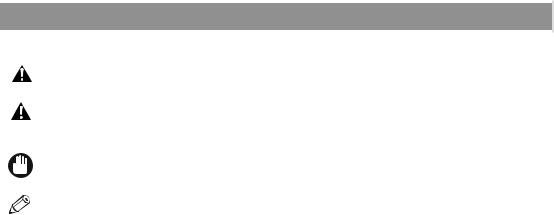

 Type Conventions Used in This Guide
Type Conventions Used in This Guide
Please read the list below of symbols, terms, and abbreviations used in this guide.
WARNING
CAUTION
IMPORTANT
• Indicates a warning concerning operations that may lead to death or injury to persons if not performed correctly. In order to use the machine safely, always pay attention to these warnings.
• Indicates a caution concerning operations that may lead to injury to persons or damage to property if not performed correctly. In order to use the machine safely, always pay attention to these cautions.
• Indicates an operational warning or restriction. Be certain to read these items to operate the machine correctly, and to avoid damage to the machine.
• Indicates a note for operation or an additional explanation. Reading these is highly recommended.
NOTE |
|
(→ p. n-nn) |
A number preceded by an arrow and enclosed in parenthesis refers to a page number in |
|
this guide which contains more information on the topic of the previous sentence. |
→ Set-Up Sheet |
Refer to the Set-Up Sheet for details on the topic of the previous sentence. |
→ Printer Guide |
Refer to the Printer Guide for details on the topic of the previous sentence. |
machine |
The word “machine” refers to the imageCLASS D340/D320 models. |
default |
A setting that remains in effect unless you change it. |
document |
The original sheet(s) of paper you copy with the machine. |
menu |
A list of settings from which you select an item to set up or change. A menu has a title |
|
which appears in the LCD. |
|
Available menus and the display differ depending on the machine type. This guide shows |
|
the display of the imageCLASS D340 model as an example. |
In addition, this guide uses distinctive typefaces to identify keys and information in the LCD:
•The keys you press appear in this typeface: Stop/Reset.
•Information in the LCD appears in this typeface: COPY SETTINGS.
vi
Where to Find Help
Before you contact Canon, please record the following information:
Serial Number (on back of machine): ________________________________
Model Name (on front of machine): _________________________________
Purchase Date: ________________________________
Here is where to find help if you are having problems with installation, or in using your machine:
In This Guide
See Chapter 8, Troubleshooting, for common problems.
On Your CD-ROM
See the Printer Guide for help with the printer driver (CARPS).
Customer Care Center
For e-mail support, the latest driver downloads and answers to frequently asked questions, visit: www.usa.canon.com/consumer
For live technical support, call 1-800-828-4040, Monday – Friday, 8 am – 8 pm EST (except holidays). 24-hour, 7 days/week automated support for troubleshooting issues on most current models, call
1-800-423-2366.
CANADA Users – call for technical support 24 hours/day, 7 days/week at 1-800-OK-CANON.
Support programs are subject to change without notice.
vii


 Legal Limitation on Usage of Your Product and the Use of Images
Legal Limitation on Usage of Your Product and the Use of Images
Using your product to scan, print or otherwise reproduce certain documents, and the use of such images as scanned, printed or otherwise reproduced by your product, may be prohibited by law and may result in criminal and/or civil liability. A non-exhaustive list of these documents is set forth below. This list is intended to be a guide only. If you are uncertain about the legality of using your product to scan, print or otherwise reproduce any particular document, and/or of the use of the images scanned, printed or otherwise reproduced, you should consult in advance with your legal advisor for guidance.
•Paper Money
•Traveler’s Checks
•Money Orders
•Food Stamps
•Certificates of Deposit
•Passports
•Postage Stamps (canceled or uncanceled)
•Immigration Papers
•Identifying Badges or Insignias
•Internal Revenue Stamps (canceled or uncanceled)
•Selective Service or Draft Papers
•Bonds or Other Certificates of Indebtedness
•Checks or Drafts Issued by Governmental Agencies
•Stock Certificates
•Motor Vehicle Licenses and Certificates of Title
•Copyrighted Works/Works of Art without Permission of Copyright Owner
viii
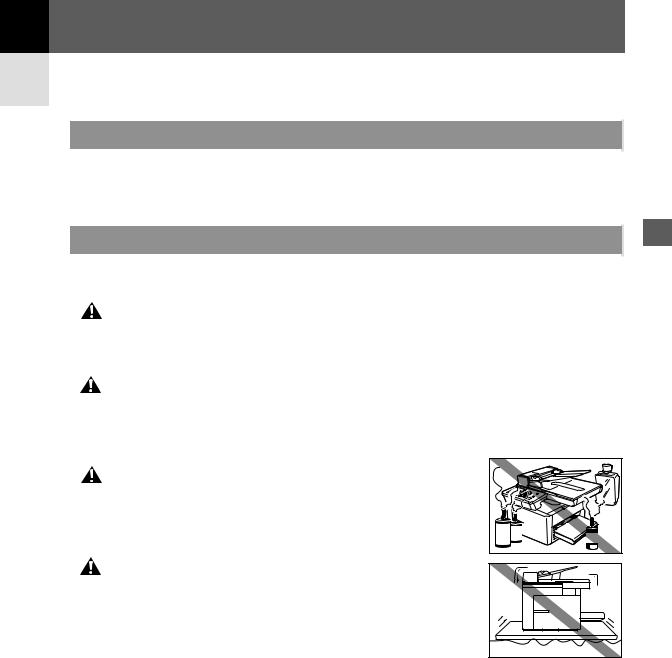
Chapter 1
Introduction

 Customer Support
Customer Support
Your machine is designed with the latest technology to provide trouble-free operation. If you encounter a problem with the machine’s operation, try to solve it by using the information in Chapter 8. If you cannot solve the problem or if you think your machine needs servicing, contact your service representative. (→ p. vii)

 Important Safety Instructions
Important Safety Instructions
Read these safety instructions thoroughly before using your machine, and keep them handy in case you need to refer to them later.
For users of a cardiac pacemaker
WARNING • This product and the cartridge emit low level magnetic flux. If you use a cardiac pacemaker and feel abnormalities, please move away from this product and the cartridge, and consult your doctor.
• Do not disassemble or modify. There are high-temperature and high-voltage components inside
CAUTION
the machine which may result in a fire or electrical shock.
•Follow all warnings and instructions marked on the machine.
■Location
• Do not place the machine near alcohol, paint thinner or other
WARNING |
inflammable substances. If inflammable substances come into |
|
|
||
|
contact with electrical parts inside the machine, it may result in a |
|
|
fire or electrical shock. |
|
CAUTION |
• Do not block or cover the ventilation port or any openings on the |
|
machine with objects, as this may result in a fire. |
||
|
||
|
• Place the machine on a flat, stable, vibration-free surface that is |
|
|
strong enough to support its weight (approx. 35.2 lb./16.0 kg |
|
|
imageCLASS D340, 31.9 lb./14.5 kg imageCLASS D320). |
•Make sure the area is free from dust.
•Avoid poorly ventilated locations.
During use, the machine generates ozone. However, the amount of ozone generated is not enough to affect the human body. Nevertheless, if the machine is used for a prolonged period of time in a poorly ventilated room, or when making a large quantity of prints, be sure to ventilate the room to make the working environment as comfortable as possible.
•Do not install the machine near devices that contain magnets or generate magnetic fields, such as speakers.
•Make sure the machine is approximately 4 inches (10 cm) away from walls and other equipment for proper ventilation.
1
Introduction
1-1
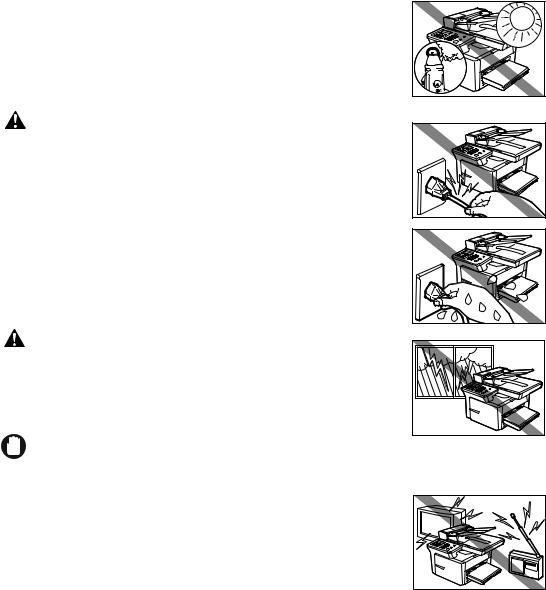
•Make sure the location is not affected by extreme temperature changes, and always stays between 59°F and 80.6°F (15°C and 27°C).
•Make sure the relative humidity of the area is between 20% and 80%.
•Keep the machine away from direct sunlight.
•Do not use or store the machine outdoors.
■Power Supply
WARNING
CAUTION
IMPORTANT
•Do not damage or modify the power cord and power plug. Also do not place heavy objects on the power cord, pull on it, or extensively bend it. These actions may cause electrical damage and result in a fire or electrical shock.
•Do not insert or unplug the power plug with wet hands, as this may result in electrical shock.
•During electrical storms, disconnect the power cord from the power outlet. Electrical storms may cause damage to the machine and result in a fire or electrical shock.
•If dust accumulates around the plug of the power cord when it is connected to a power outlet, unplug the machine and wipe the plug with a clean, dry cloth.
•Do not plug the machine into the same circuit with appliances such as an air conditioner, television or copier. These devices generate an electrical noise, and may interfere with your machine’s ability.
•Plug the machine into a standard 120 V AC/60 Hz, three-prong grounded outlet. Operate the machine only from the type of power source indicated on the machine’s label. If you are not sure of the type of power available, consult your local power company.
•Use only the power cord that came with the machine.
•Unplug the machine in the following conditions:
–When the power cord or plug is damaged or frayed.
–If liquid has spilled into the machine.
–If the machine has been exposed to rain or water.
–If the machine does not operate normally when you have followed the instructions in the guides included with your machine. Adjust only those controls that are covered by the instructions in the guides since improper adjustment of other controls may result in damage and will often require extensive work by a qualified technician to restore the product to normal operation.
–If the machine has been dropped or damaged.
–If the machine exhibits a distinct change in performance, indicating a need for servicing.
1-2
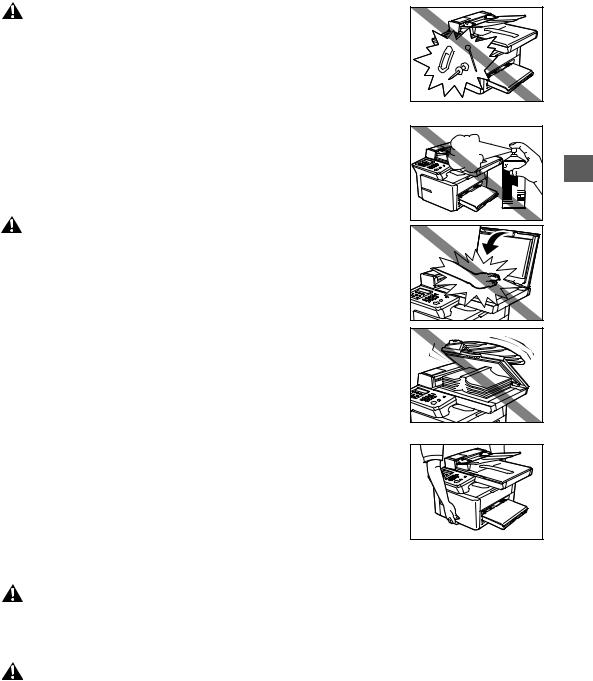
■ Handling
• Do not drop paper clips, staples, or other metal objects inside the
WARNING |
machine. Also do not spill water, liquid or inflammable substances |
|
|
|
inside the machine. If these items come into contact with high-voltage |
|
parts inside of the machine, it may result in a fire or electrical shock. |
|
If these items are dropped or spilled in the machine, unplug the |
|
power cord immediately with dry hands. Then, contact your service |
|
representative. |
|
• Do not use any highly flammable spray near the machine. If gas |
|
|
from a spray comes into contact with the electrical components |
|
|
inside the machine, it will result in a fire. |
1 |
|
|
|
CAUTION |
• Close the ADF or the platen glass cover gently to avoid catching |
Introduction |
|
your hand. Failing to do so may result in personal injury. |
|
• Do not press down hard on the platen glass cover when using the platen glass to scan a thick book. This may damage the platen glass and/or result in personal injury.
• Do not subject the machine to strong physical shock or vibration.
• Unplug the machine before moving it.
• Do not lift the machine by any of its attachments.
• If the machine exhibits a distinct change in performance, this indicates a need for servicing.
■ Maintenance
• Do not place the cartridge in fire. Toner powder is flammable.
WARNING
• Keep the machine clean. Dust accumulation may prevent the machine from operating properly.
• Do not service the machine yourself except as specifically described in this guide. If further
WARNING |
servicing is required, contact your service representative. |
|
1-3
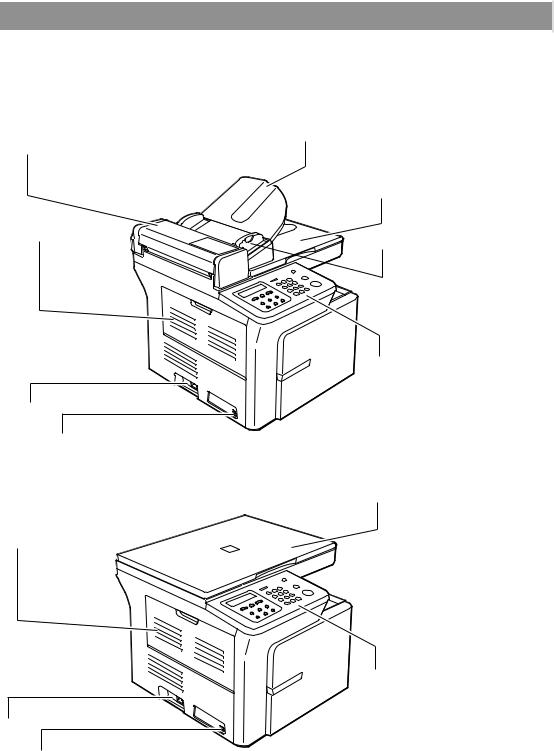

 Main Components of the Machine
Main Components of the Machine
This section describes the main components of the machine.
Left Side View
■ imageCLASS D340
ADF (AUTOMATIC DOCUMENT FEEDER)
Holds documents for copying and feeds them automatically into the scanning unit.
LEFT COVER
Open it when you output paper face up or remove jammed paper.
POWER CORD CONNECTOR
USB INTERFACE CONNECTOR
DOCUMENT FEEDER TRAY
Place documents for copying.
DOCUMENT OUTPUT TRAY
Documents come out here.
SLIDE GUIDE
Adjust to the width of the document.
OPERATION PANEL
Controls the machine.
■ imageCLASS D320
LEFT COVER
Open it when you output paper face up or remove jammed paper.
POWER CORD CONNECTOR
PLATEN GLASS COVER
Open it when you place documents on the platen glass for copying.
OPERATION PANEL
Controls the machine.
USB INTERFACE CONNECTOR
1-4
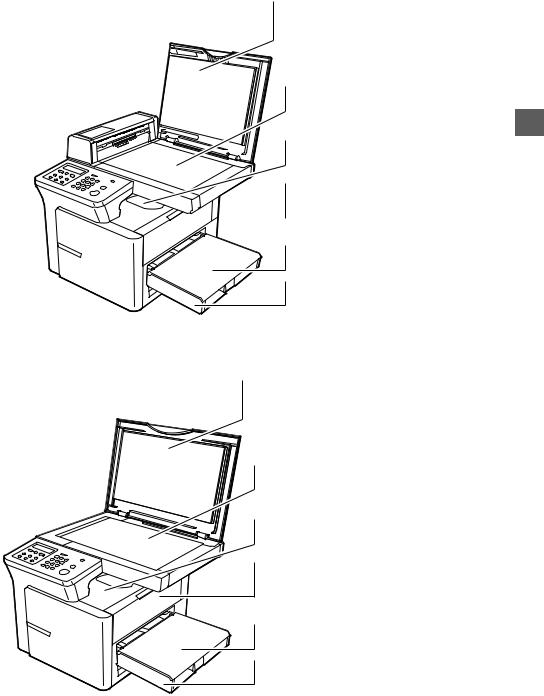
Right Side View
■ imageCLASS D340
PLATEN GLASS COVER
Open it when you place documents on the platen glass for copying.
PLATEN GLASS
Place documents for copying.
OUTPUT TRAY
Outputs printed pages.
RIGHT COVER
Open it when you install the cartridge,  or remove jammed paper.
or remove jammed paper.
MULTI-PURPOSE TRAY
Load paper stack.
CASSETTE
Load paper stack.
■ imageCLASS D320
PLATEN GLASS COVER
Open it when you place documents on the platen glass for copying.
PLATEN GLASS
Place documents for copying.
OUTPUT TRAY
Outputs printed pages.
RIGHT COVER
Open it when you install the cartridge or remove jammed paper.
MULTI-PURPOSE TRAY
Load paper stack.
CASSETTE
Load paper stack.
1
Introduction
1-5
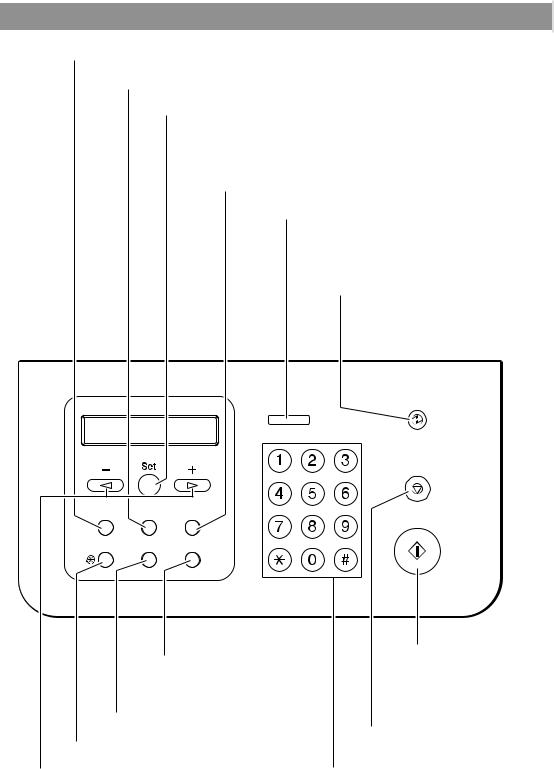

 Operation Panel
Operation Panel
This section describes keys used when making copies and setting the Additional Functions.
Enlarge/Reduce key
Sets an enlargement or reduction ratio of the copy.
Exposure key
Adjusts the copy exposure.
Set key
Determines the contents you set or register. Also, if the document being scanned stops in the ADF, pressing this key makes the document come out automatically.
Image Quality key
Adjusts the quality of copy image.
Memory/Alarm indicator
Lights green during copying or when the copy job is stored in memory and flashes red when the machine has a problem such as a paper jam. (The error message is displayed in the LCD.)
Energy Saver key
Sets or cancels the energy saver mode manually. The key lights green when the energy saver mode is set,
and goes off when the mode is canceled.
Energy Saver
Memory Alarm
Enlarge / |
Exposure |
Image Quality |
Reduce |
||
Additional |
Collate/ |
Status |
Functions |
2on1 |
Monitor |
Status Monitor key
Checks the status of print, copy and report jobs.
Collate/2 on 1 key
Sorts copies in order of pages or reduces 2 letter-size documents to fit on a
single letter-size sheet.
Additional Functions key
Customizes the way your machine operates.
4 (–) , e (+) keys
Scroll through the selections so you can see other settings.
Stop/Reset
Start
Start key
Starts copying.
Stop/Reset key
Cancels copying and other operations, and returns the machine to standby mode.
Also, this key is used to confirm the copy job you reserved.
Numeric keys
Enter copy quantity and other numerical values.
1-6


 Standby Display
Standby Display
The standby display is as follows:
Copy Ratio |
|
|
|
|
|
|
|
|
|
|
|
|
Paper Size |
|
|||||||||||||||||||||||||||||||||||||||
|
|
|
|
|
|
|
|
|
|
|
|
|
|
|
|
|
|
|
|
|
|
|
|
|
|
|
|
|
|
|
|
|
|
|
|
|
|
|
|
|
|
|
|
|
|
|
|
|
|
|
|
|
|
|
|
|
|
|
|
|
|
|
|
|
|
|
|
|
|
|
|
|
|
|
|
|
|
|
|
|
|
|
|
|
|
|
|
|
|
|
|
|
|
|
|
|
|
|
|
|
|
|
|
|
|
|
|
|
|
|
|
|
|
|
|
|
|
|
|
|
|
|
|
|
|
|
|
|
|
|
|
|
|
|
|
|
|
|
|
|
|
|
|
|
|
|
|
|
|
|
|
|
|
|
|
|
|
|
|
|
|
Exposure |
Image Quality |
Copy Quantity |
 • When the machine is plugged in, the LCD displays PLEASE WAIT for a while, then the standby display NOTE appears.
• When the machine is plugged in, the LCD displays PLEASE WAIT for a while, then the standby display NOTE appears.
1
Introduction
1-7
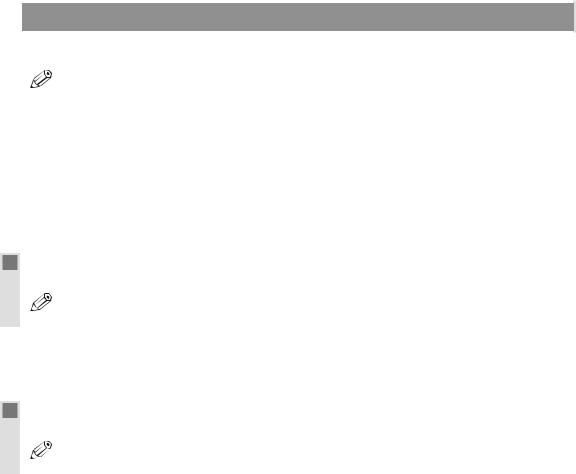

 Energy Saver Mode
Energy Saver Mode
This machine provides an energy saver function. When no operations are performed for about 5 minutes, the machine automatically enters the energy saver mode.
• The time until the machine enters the energy saver mode can be specified in a range of 3 minutes to 30
NOTE |
minutes. You can also turn off the energy saver function. (→ p. 9-4) |
|
•The energy saver function does not activate when the machine is in the following status:
–When printing out copies or other pages
–While a copy job is saved in memory or when the reserve copy or other functions are operating
–When paper jams occur
–When no paper is loaded in the cassette or multi-purpose tray
–When PRESS SET KEY is displayed

 Setting the Energy Saver Mode Manually
Setting the Energy Saver Mode Manually
1Press Energy Saver.
• The LCD is turned off and the Energy Saver key lights up.
• Right after the machine is restored from the energy saver mode, or right after copying finishes, wait
NOTE |
about 2 seconds before pressing Energy Saver. |
|

 Restoring from the Energy Saver Mode
Restoring from the Energy Saver Mode
1Press Energy Saver.
• The Energy Saver key goes off and the machine enters standby mode.
• The machine can be restored from the energy saver mode immediately. However, it may vary according
NOTE |
to room temperature and circumstances. |
|
1-8

Chapter 2
Paper Handling

 Print Media Requirements
Print Media Requirements
For high-quality copies, we recommend using paper and transparencies recommended by Canon. Some types of paper available at office supply stores may not be suitable for this machine. If you have any questions about paper and transparencies, consult your dealer or Canon Customer Relations.
Paper Storage
In order to prevent paper jams, follow the procedure below:
•To prevent moisture buildup, store remaining paper wrapped tightly in its original package. Store paper in a dry location, out of direct sunlight.
•To prevent curling, store paper flat, not upright.
•After copying, do not leave paper in the multi-purpose tray.
Unacceptable Paper
Do not copy on the following types of copy stock; doing so will result in paper jams.
•Severely curled or wrinkled paper
•Transparencies for full-color copiers or printers
•Paper which has already been copied using a digital full-color copier (Do not copy on the reverse side either.)
•Paper which has been printed on using a thermal transfer printer (Do not copy on the reverse side either.)
 • Never attempt to make copies on full-color transparencies. Doing so may result in copier malfunction.
• Never attempt to make copies on full-color transparencies. Doing so may result in copier malfunction.
IMPORTANT
2
Paper Handling
Acceptable Paper
|
|
|
Cassette/Multi-purpose Tray |
|
|
Paper size |
|
Letter, Legal, Executive, A4, B5, A5 |
|
|
|
|
Envelope : COM10, MONARCH, DL, ISO-C5 |
|
|
|
|
Free Size : 8.5 (216.0 mm) × 14 in. (356.0 mm)[max.] / |
|
|
|
|
3 (76.2mm) × 5 in. (127.0 mm)[min.] |
|
|
|
|
|
|
|
Paper weight |
|
17 - 32-lb bond or 64 - 128 g/m2 |
|
|
|
|
|
|
|
Type of paper |
|
– Plain paper (17 - 24-lb bond or 64 - 90 g/m2) |
|
–Transparencies
–Special paper 1 (25 - 32-lb bond or 91 - 128 g/m2) (Thick paper)
–Special paper 2 (Rough paper)
•The printing speed may be slower than usual depending on the paper size, paper type and the number of
NOTE |
sheets you specify. |
|
|
|
This is because the safety function works to prevent a failure due to excessive heat. |
2-1
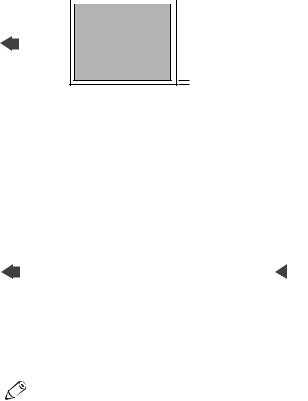

 Printing Areas
Printing Areas
The term “printing area” represents both the recommended area for optimum print quality and the entire area where the machine can technically print from your computer.
Printing area (light shade) : Canon recommends that you print within this area.
■ Paper
13/64" (5 mm) |
15/64" (6 mm) |
|||||
|
|
|
|
|
|
5/32" |
|
|
|
|
|
||
|
|
|
|
|
|
(4 mm) |
|
|
|
|
|
|
|
FEEDING Letter/Legal
DIRECTION
5/32" (4 mm)
■ Envelope
13/32" (10 mm) |
13/32" (10 mm) |
|
13/32" (10 mm) |
13/32" (10 mm) |
|||||||||||||
|
|
|
|
|
13/32" |
|
|
|
|
|
|
|
|
13/32" |
|||
|
|
|
|
|
|
|
|
|
|
|
|||||||
FEEDING |
|
|
|
|
|
(10 mm) |
|
FEEDING |
|
|
|
|
|
|
|
|
(10 mm) |
|
|
COM10 |
|
|
|
|
|
|
DL |
|
|
|
|
|
|
||
|
|
|
|
|
|
|
|
|
|
|
|
|
|
||||
DIRECTION |
|
|
|
|
|
|
DIRECTION |
|
|
|
|
|
|
|
|
||
|
|
|
|
13/32" |
|
|
|
|
|
|
|
13/32" |
|||||
|
|
|
|
|
|
|
|
|
|
|
|
|
|||||
|
|
|
|
|
|
(10 mm) |
|
|
|
|
|
|
|
|
|
|
(10 mm) |
• The scanning areas when you copy are a little larger than printing areas. (→ p. 3-2)
NOTE
2-2
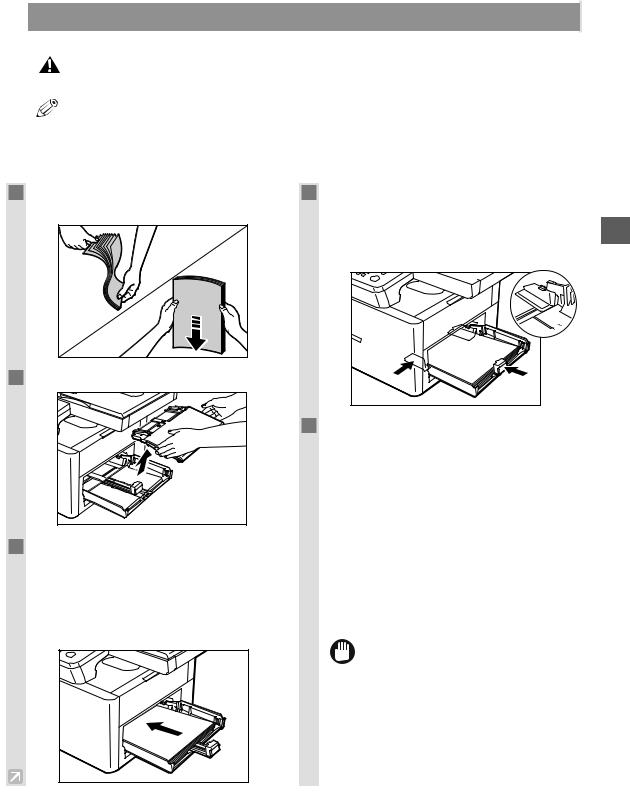

 Loading Paper
Loading Paper
This section describes how to load paper in the cassette and in the multi-purpose tray.
• When loading paper, take care not to cut your hands on the edges of the paper.
CAUTION
• The paper in the multi-purpose tray is fed prior to the paper in the cassette.
NOTE • The cassette holds up to approximately 250 sheets of 17 to 20-lb bond (64 g/m2 to 80g/m2).

 Loading Paper in the Cassette
Loading Paper in the Cassette
1
2
3
Fan the paper stack first, then tap the edges 4 on a flat surface to even the stack.
Remove the multi-purpose tray.
5
Load the paper stack in the cassette.
•Insert the paper stack into the cassette as far as it will go.
•When you insert paper with a logo on, position the paper with the print side up (logo side) and load it so that the top of the paper feeds first in the cassette.
Adjust the slide guides to fit the size of the paper stack.
• Adjust the slide guides so that there is no space |
2 |
|
|
between the slide guides and the edge of the paper |
|
stack. 

 Handling
Handling 




 Paper
Paper
When loading paper other than letter size, specify the paper size.
Press Additional Functions, then select:
PAPER SETTINGS PAPER SIZE
Use 4 (–) or e (+) to select the appropriate paper size (LTR, LGL, EXECUTIV, ENVELOPE, FREESIZE, A4, B5 or A5).
To set the Additional Functions, see "Accessing the Additional Functions". (→ p. 9-1)
•For details, refer to "Specifying the Paper Size and
the Type (Common for Cassette and Multi-purpose Tray)". (→ p. 4-3)
•Do not load different kinds of paper at the same time.
IMPORTANT • Do not load extra paper when there is still paper left in the cassette.
•If you load extra paper while making copies, remove the loaded paper first. Then put it together with the extra paper and tap the edges. After that, reload it in the cassette.
2-3
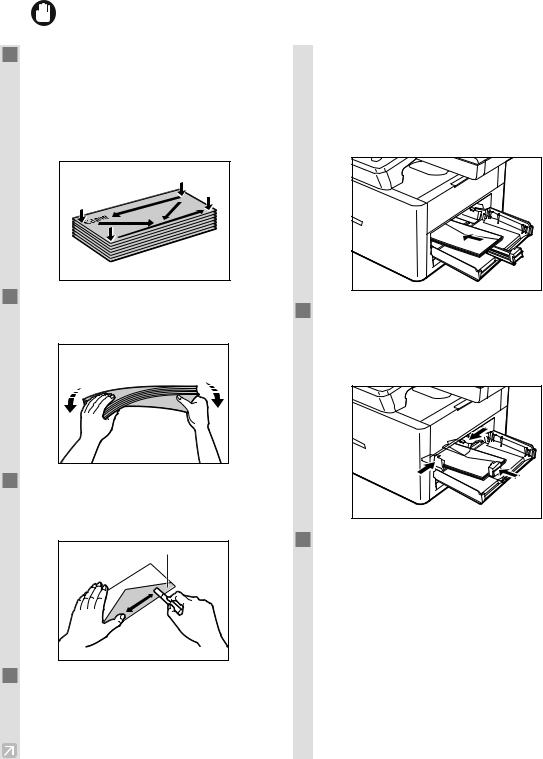

 Loading Envelopes in the Cassette
Loading Envelopes in the Cassette
• |
The recommended envelopes are COM10, MONARCH, DL, ISO-C5. |
IMPORTANT |
Using other envelopes may affect the quality of the copy image. |
1Arrange the stack of envelopes on a firm, clean surface, and press down firmly on the edges to make the folds crisp.
•Press all the way around the envelopes to remove any curls and expel air from inside the envelopes. Also, press firmly on the area that corresponds to the edges of the back flap.
•If the envelope to be loaded has a flap on the short edge, this edge must enter the machine first. Not loading it this way will result in paper jams.
•After loading envelopes, push them lightly toward the inside of the machine.
•The cassette holds up to approximately 20 envelopes.
2
3
4
Remove any curling from the envelopes by holding the edges diagonally and bending 5 them gently.
Run a pen or other rounded object along the back flaps to flatten them.
• The flaps should not bulge more than 0.2 inch
(5 mm).
6
 Flap
Flap
Even the edges of the envelopes and load them in the cassette.
•Position the envelopes with the print side up (flaps should not be visible) and load them so that the left side (sender's address side) feeds first in the cassette.
Adjust the slide guides to fit the size of the envelopes.
•Adjust the slide guides so that there is no space between the slide guides and the edge of the envelopes.
Specify the envelope size and type.
•Press Additional Functions, then select:
PAPER SETTINGS PAPER SIZE
ENVELOPE
Use 4 (–) or e (+) to select the envelope type (COM10, MONARCH, DL, ISO-C5).
To set the Additional Functions, see "Accessing the Additional Functions". (→ p. 9-1)
•For details, refer to "Specifying the Paper Size and
the Type (Common for Cassette and Multi-purpose Tray)". (→ p. 4-3)
2-4
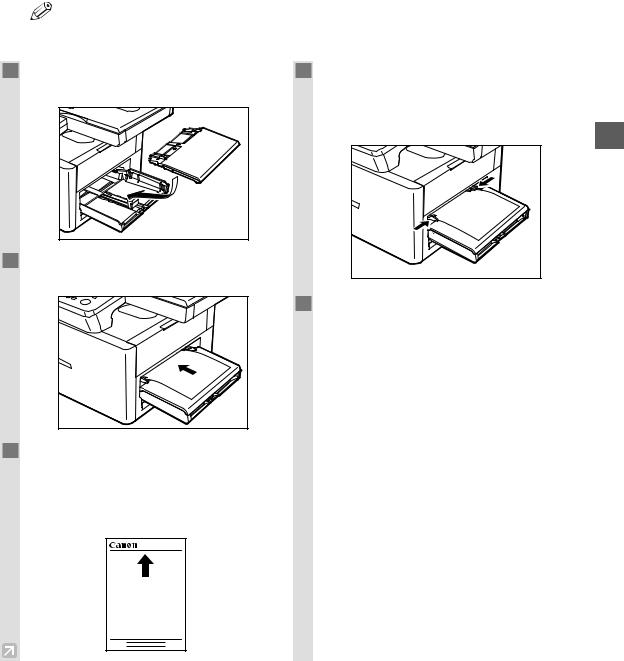

 Loading Paper in the Multi-purpose Tray
Loading Paper in the Multi-purpose Tray
Use the multi-purpose tray when you want to copy or print on paper of a different type from that loaded in the cassette. You can load up to 10 sheets of letter-size (20-lb bond or 75 g/m2) paper, or a single sheet of any other type of compatible paper.
• The multi-purpose tray has priority over the cassette.
NOTE
1
2
3
Set the multi-purpose tray on the top of |
4 |
cassette. |
|
Insert the paper with the print side up in the multi-purpose tray.
5
When you insert paper with a logo on, position the paper with the print side up (logo side) and load it so that the top of the paper feeds first in the multi-purpose tray.
Adjust the slide guides to fit the size of the paper.
•Adjust the slide guides so that there is no space between the slide guides and the edge of the paper.
2
Paper Handling
Specify the paper size.
•To specify the paper size, follow the procedure below:
Press Additional Functions, then select:
PAPER SETTINGS
PAPER SIZE
Use 4 (–) or e (+) to select the appropriate paper size (LTR, LGL, EXECUTIV, ENVELOPE, FREESIZE, A4, B5 or A5).
To set the Additional Functions, see "Accessing the Additional Functions". (→ p. 9-1)
•For details, refer to "Specifying the Paper Size and
the Type (Common for Cassette and Multi-purpose Tray)". (→ p. 4-3)
2-5
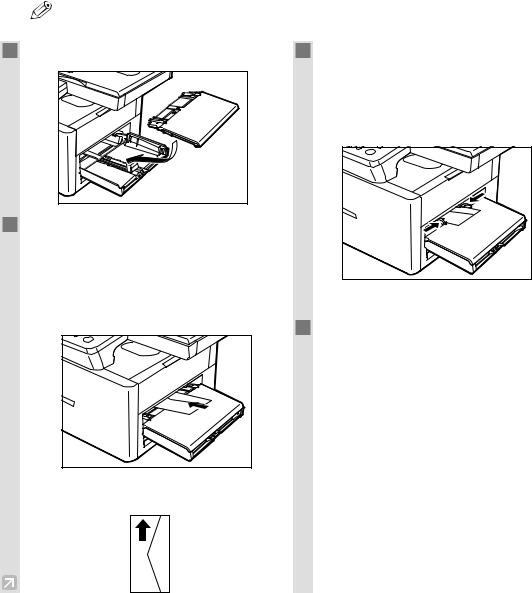

 Loading an Envelope in the Multi-purpose Tray
Loading an Envelope in the Multi-purpose Tray
Use the multi-purpose tray when you want to copy or print an envelope one by one.
• The multi-purpose tray has priority over the cassette.
NOTE
1 Set the multi-purpose tray.
2Insert an envelope with the print side up (a flap should not be visible) and load it so that the left side (sender's address side) feeds first in the multi-purpose tray.
•If the envelope to be loaded has a flap on the short edge, this edge must enter the machine first. Not loading it this way will result in paper jam.
3Adjust the slide guides to fit the size of the envelope.
•Adjust the slide guides so that there is no space between the slide guides and the edge of the envelope.
4Specify the envelope size and type.
•Press Additional Functions, then select:
PAPER SETTINGS PAPER SIZE
ENVELOPE
Use 4 (–) or e (+) to select the envelope type (COM10, MONARCH, DL, ISO-C5).
To set the Additional Functions, see "Accessing the Additional Functions". (→ p. 9-1)
•For details, refer to "Specifying the Paper Size and
the Type (Common for Cassette and Multi-purpose Tray)". (→ p. 4-3)
2-6
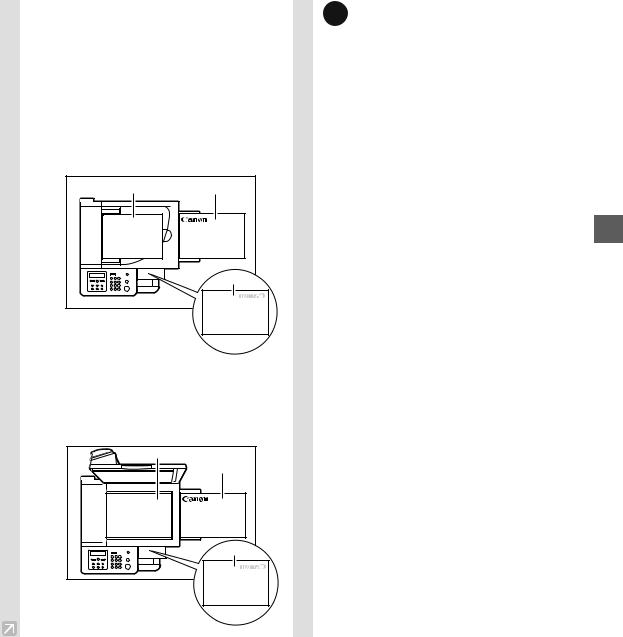
 • When you place the document on the NOTE platen glass, the orientation of the
• When you place the document on the NOTE platen glass, the orientation of the
document and the loading orientation of the paper are reversed.
When you place the document in the ADF (only for the imageCLASS D340), the orientation of the document and the orientation of the paper in the cassette or in the multi-purpose tray are as shown below.
Document |
Paper |
ABC |
|
|
Copy |
|
ABC |
When you place the document on the platen glass, the orientation of the document and the orientation of the paper in the cassette or in the multi-purpose tray are as shown below.
Document |
Paper |
ABC |
Copy |
ABC |
 • If the slide guides are not adjusted correctly IMPORTANT for the paper size, the quality of your copy
• If the slide guides are not adjusted correctly IMPORTANT for the paper size, the quality of your copy
images may be adversely affected.
 • When you insert an envelope and thick NOTE paper, push the paper toward the inside of
• When you insert an envelope and thick NOTE paper, push the paper toward the inside of
the machine lightly to feed paper firmly.
•If the paper is curled, uncurl it before placing it in the cassette or multi-purpose tray. Failure to do so will cause paper creases and a paper jam.
•Some types of paper may not feed properly into the cassette or multi-purpose tray. For high-quality copies, be sure to use the
paper and transparencies recommended by Canon. (→ p. 2-1)
•When making copies of a small size document or thick paper, etc., the copy speed may be slightly slower than usual.
2
Paper Handling
2-7
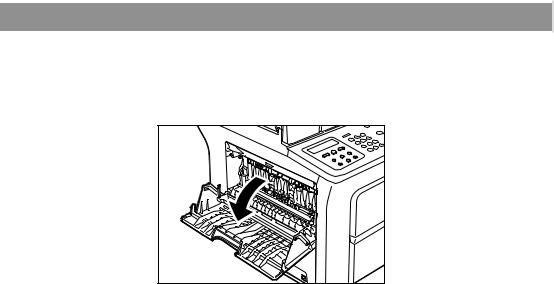

 Selecting the Paper Output Area
Selecting the Paper Output Area
Face down paper output delivers paper with the printed side down.
Face up paper output delivers paper with the printed side up. Select the output area depending on your purpose by opening or closing the left cover.
Open the left cover for face up paper output or close the left cover for face down paper output.
 • Do not open or close the left cover while copying and printing.
• Do not open or close the left cover while copying and printing.
IMPORTANT

 Paper Type and Paper Output Area
Paper Type and Paper Output Area
Select the suitable paper output area depending on the paper type and your purpose.
|
Paper Type |
|
Paper Output Area |
|
The Number of Output Sheets |
|||
|
Plain paper |
|
face up |
|
1 sheet |
|||
|
|
|
|
|
|
|
|
|
|
|
|
|
face down |
|
approx. 50 sheets (64-80 g/m2) |
||
|
|
|
|
|
|
|
|
|
|
Transparencies |
|
face up |
|
1 sheet |
|||
|
|
|
|
|
|
|
|
|
|
|
|
|
face down |
|
10 sheets |
||
|
|
|
|
|
|
|
|
|
|
Labels |
|
face up |
|
1 sheet |
|||
|
|
|
|
|
|
|
|
|
|
|
|
|
face down |
|
10 sheets |
||
|
|
|
|
|
|
|
|
|
|
Envelopes |
|
face up |
|
1 sheet |
|||
|
|
|
|
|
|
|
|
|
|
|
|
|
face down |
|
10 sheets |
||
|
|
|
|
|
|
|
|
|
2-8
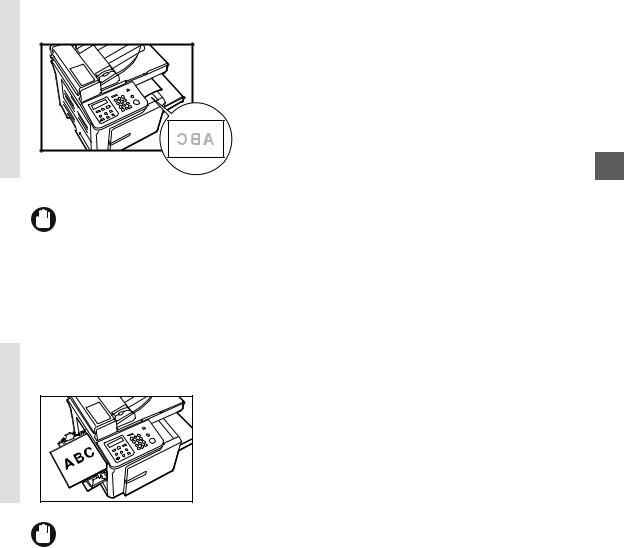

 Face Down Paper Output Area
Face Down Paper Output Area
The paper is delivered with the printed side down on the output tray.
Paper is stacked in printed order.
With left cover, closed.
• Do not place the output paper back on the output tray.
IMPORTANT • Do not place things other than paper on the output tray.
• If you do these things, a paper jam may occur.

 Face Up Paper Output Area
Face Up Paper Output Area
Face up paper output is convenient for paper media such as transparencies and labels, because the paper is delivered straight through the machine.
With left cover, open.
• Remove the paper output one by one.
• Do not pull the paper forcibly.
IMPORTANT • This machine has no face up output tray. Remove the delivered paper with your hand.
• Do not place obstacles in front of the face up paper output area to prevent paper jam.
2
Paper Handling
2-9
